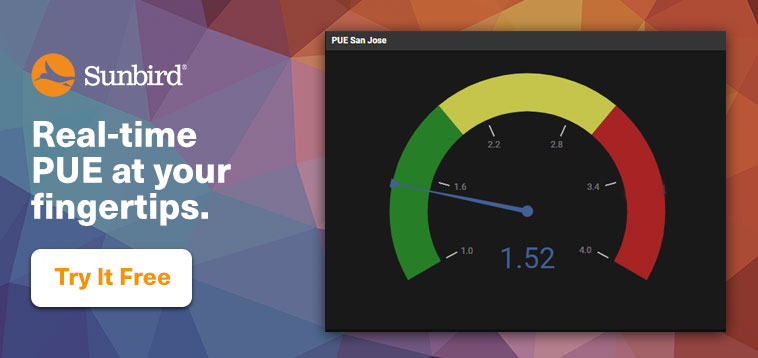What’s the Best PUE Ratio for Data Centers?
Power Usage Effectiveness (PUE) is a ratio of the total amount of power used by a data center to the power delivered to IT equipment. The PUE metric was developed by The Green Grid to measure the overall energy efficiency of data centers, and it has been one of the most popular data center KPIs since its introduction in 2007.
Expressed as a formula, the PUE ratio is calculated as such:
PUE = Total Facility Energy / IT Equipment Energy
With a renewed focus on increasing data center sustainability, many data center professionals must measure and improve their energy efficiency to meet corporate sustainability initiatives. This often leads to the question, “What is the best PUE ratio?”
The best PUE ratio is 1.0.
A PUE of 1.0 indicates a perfectly efficient data center in which 100% of the facility’s power is delivered to IT equipment. This means that no power is used for any other purpose in the facility such as cooling, lighting, or any other overhead that supports the equipment.
Is a PUE Ratio of 1.0 Possible?
The data center industry is one of the world’s biggest pioneers in sustainability and green technology, and the leaders in this space are making incredible innovations in data center energy efficiency.
While a PUE ratio of 1.0 is the theoretical best-case scenario, green data centers around the world have been able to make progress towards this goal.
Here are some of the most efficient data centers:
- LinkedIn’s Hilltop, OR data center has a PUE of 1.06 by leveraging by using a waterside economizer that communicates with outside air sensors to take advantage of the naturally cool climate for free cooling
- Microsoft’s Project Natick is an experimental underwater data center that achieved a PUE of 1.07 by using seawater to cool equipment
- Facebook’s global data centers combine for a PUE of 1.11
- United Airlines’ Chicago data center has a PUE of 1.09 due to advancements in air-to-air heat transfer technology
- BitFury’s data center in Tbilisi, Georgia has a PUE of 1.02 due to two-phase immersion cooling
- NREL’s Golden, CO site has a PUE of 1.04 by using blade servers with variable speed fans and energy-efficient power supplies, virtualizing 70% of their environment, and using low-energy cooling techniques
- Verne Global’s data center Keflavik, Iceland achieved a PUE of 1.06 by leveraging free air cooling, geothermal steam, and hydroelectricity from glacial rivers
- Lefdal Mine Data Center in Maloy, Norway earned a PUE of 1.15 by using a nearby fjord for cooling and power generation
- Green House Data’s data center in Cheyenne, WY has a PUE of 1.14 because of their use of cool and dry air for free cooling
What Should My PUE Ratio Be?
According to Uptime Institute, the average data center’s PUE is 1.58 as of 2020. This is a large improvement over 2007’s average of 2.5.
New data centers that are constructed with state-of-the-art technology and deploy modern equipment should target a PUE ratio of around 1.2 but no higher than 1.4.
Existing data center footprints should strive for a PUE of 1.5 or less.
How Do I Calculate My PUE Ratio?
There are two ways to calculate your PUE ratio: the hard way and the easy way.
The hard way consists of manually calculating the values for total facility energy and IT equipment energy and then dividing them.
Total facility energy can be established with a utility meter reading. Installing a “shadow meter” can allow you to record daily measurements rather than waiting for the bill each month.
IT equipment energy can be calculated by summing up the power readings of the power distribution equipment that provides power to your racks (i.e., floor PDUs, UPSs, intelligent rack PDUs).
Divide the total facility energy by the IT equipment energy, and you have your PUE ratio.
The easy way is to deploy Data Center Infrastructure Management (DCIM) software. The software will automatically collect data from building feeds, IT loads, and non-IT loads, calculate the PUE ratio for all your sites in real-time, and consolidate that information into actionable charts and reports.
With DCIM software, you can focus on energy efficiency initiatives and more productive work rather than time-consuming, manual, and potentially inaccurate PUE math.
How Do I Improve My PUE Ratio?
Once you know how to measure your PUE ratio and what your goal PUE is, it’s time to begin energy efficiency initiatives that will help you achieve your goals and meet corporate sustainability initiatives.
Fortunately, by following best practices and deploying a complete data center management solution, you can dramatically increase efficiency and reduce your PUE ratio.
Best practices to improve your PUE ratio include:
- Meter and monitor your power and environment. Metered power infrastructure such as intelligent rack PDUs provides data on your power utilization, and environment sensors (i.e., temperature and humidity) let you know if your equipment is operating within recommended ranges. By deploying these meters and sensors and leveraging DCIM software to automatically collect, store, report, and alert on the data, you can be the first to know of potential issues so you can remediate them and maintain high levels of efficiency.
- Increase temperature setpoints. Modern IT equipment is designed to withstand high temperatures, but many data center professionals play it safe and overcool their equipment. Since cooling can account for 50% of a data center’s energy consumption, this practice wastes energy and wastes money. Implement temperature sensors in all your cabinets to ASHRAE guidelines and monitor them with DCIM software. Built-in ASHRAE cooling charts will help you easily understand where you are overcooling equipment. Then, you can slowly raise your temperature setpoints—or even turn them off in some cases—until you are maximizing the efficiency of your infrastructure.
- Implement hot/cold aisle containment. When cold supply air mixes with hot exhaust air, your cooling system wastes energy to cool air that is already cold. Instead, it is best practice to separate the hot and cold air as much as possible. Hot aisle containment and cold aisle containment are two strategies that can dramatically reduce energy consumption, increase cooling capacity, and unlock more power capacity for IT equipment.
- Consolidate and/or virtualize equipment. By decreasing the number of physical assets in your data center, you reduce the amount of space, power, and cooling capacity needed to support them. Up to 30% of servers may be “zombies” or “ghost servers” that are consuming energy but not performing any useful function. With outlet-metered rack PDUs and DCIM software, you can easily run a report of all your ghost servers and decommission them. This makes it easier to consolidate or virtualize the remaining servers.
- Bill back customers for their energy consumption. Internal and/or external customers may not always follow energy efficiency best practices. However, you can drive a culture of awareness and accountability by charging them for the energy they use. Use DCIM software to generate bill back reports so you can see energy costs by customer, business unit, or application and ensure your charges are always accurate. The results are that customers are encouraged to become more mindful of efficiency and your PUE drops.
Bringing It All Together
While theoretically, the best PUE ratio is 1.0, ultimately the best PUE for you depends on the age of your data center, the geographic location of your data center, how modern your technology is, and other factors that are not always in your control.
Your goal should be to get your PUE ratio as low as possible without introducing risk to your data center.
Modern data center managers around the world are finding that intelligent power distribution infrastructure, environment sensors, and DCIM software form the complete solution that provides the actionable insights needed to dramatically improve their PUE. Is it time for you to explore the possibilities of modern energy management?
Want to see how Sunbird’s world-leading DCIM software makes it easy to automatically calculate, trend, and compare your PUE ratio across all your sites? Get your free test drive today!






























